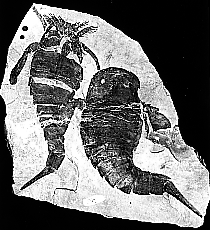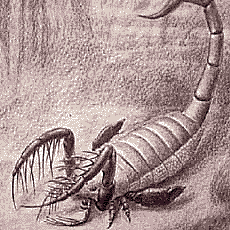 |
 |
 |
 |
Eurypterids : On the left, Eurypterus, is from the Silurian of New York state, USA (the fossil Eurypterus remipes was adopted as the state fossil in 1984). At right, Mixopterus a rather fearsome predator of the Devonian that grew to be about a meter in length. The reconstruction is from a display at the Paleontological Institute in Moscow.
The eurypterids were among the largest and most fearsome marine predators of the Paleozoic. While the smallest were only about 10 centimeters, some reached more than two meters (six feet) in length, making them the largest arthropods that ever lived. They arose in the Ordovician, and the last ones went extinct in the Permian. Most have been found in rocks that were laid down in brackish water or freshwater; the earliest groups may have lived in the sea, and some eurypterids may have spent at least short intervals on land.
Eurypterids fossils are known from all continents, and have such amazingly good preservation that their external structure is the best known of all extinct animals. Because of their long tails and the spine-like appendage at the tip, the eurypterids have been called sea-scorpions. And in fact they are closely related to scorpions and other arachnids.
For more information:
View Lepidoderma mazonense, a fossil eurypterid from Mazon Creek, Illinois. Brought to you by the Illinois State Museum. And see some fossils of eurypterid tails from Kansas in Rich Leizler's Kansas Fossils site.
Jason Dunlop of the University of Manchester has reported finding slit-like structures and book lungs on some eurypterid fossils. Such structures are today known only in arachnids.

Source: Stormer, L. 1955. Merostomata. pp. P4-P41 in Moore, R.C. (ed.) Treatise on Invertebrate Paleontology. Part P: Arthropoda 2: Chelicerata. Geological Society of America and University of Kansas Press, Lawrence, Kansas.

